Why Do Galaxies Start Out as Cosmic Pickles?
By Joel R. Primack
A geometric mystery from deep space is sharpening the computer models used to understand the complex history of the universe and to peer into its far future.
A geometric mystery from deep space is sharpening the computer models used to understand the complex history of the universe and to peer into its far future.

Long before anyone was studying galaxies—long before anyone even knew that other galaxies existed—Isaac Newton derived the basic rules that govern their structures.
His theory of gravity held that every object with mass attracts every other object with a force that is proportional to the product of their masses and that falls off as the square of their distance. Newton’s law of universal gravitation, combined with his laws of inertia and acceleration, provided the basic tools for understanding the path of every freely moving object, whether here on Earth, in the Solar System beyond, or in distant galaxies. Putting these tools to use has not been easy, however.
In the Solar System, Newton realized that his physics could account for the elliptical shapes of the orbits of planets, moons, and comets. It could also account for their orbital speeds, and could be used to predict their locations to high precision. What Newton could not do was explain why all the planets orbit the Sun in the same direction in the same plane in nearly circular orbits. This failure illustrates a deep truth that continues to shape so much research in astronomy and astrophysics: It is much easier to study the current state of a celestial object than it is to understand how it came to be that way.
For want of a better answer, Newton concluded that the stable order of the Solar System must have a divine origin. In a 1692 letter to the English theologian Richard Bentley, he wrote that “the motions which the Planets now have could not spring from any naturall cause alone but were imprest by an intelligent Agent.”
A century later, the French natural philosopher Pierre-Simon Laplace refused to cede the planetary motions to the hand of God. “Such an extraordinary phenomenon can hardly have haphazard causes; it suggests that a general cause has established all of the motions,” he wrote in Exposition du système du monde (1796). He theorized that the Solar System emerged from a collapsing gas cloud. As the cloud cooled and shrank, it rotated faster and flattened because of angular momentum conservation, the same reason that an ice skater spins faster when she pulls in her arms. Laplace suggested that the Sun formed at the center, while the whirling cloud spun off concentric rings of gas that condensed into planets all revolving in the same direction and in the same plane.
Laplace had the right idea, but his thinking was too simplistic. He proposed that glowing swirls known as spiral nebulae (Latin for clouds) in the night sky were examples of proto- stellar contracting gas clouds, whereas we now know they are actually distant galaxies. He also erred in his conception of how gas rings would form and condense. Using powerful modern telescopes, though, we can see that there are true rotating gas clouds forming stars and planetary systems, much as Laplace had supposed.
We expected that early galaxies would look different,but the shapes that we saw still surprised us.
Like many astrophysicists, I naively expected that galaxies formed in a Laplacian style, with gas clouds rotating faster as they shrank to form disks. It turns out that our thinking was too simplistic as well. Starting about six years ago, astronomers used the Hubble Space Telescope to examine what early galaxies really looked like. Most of those early galaxies were not shaped like disks after all. Rather, they looked like cosmic pickles!
We are still making sense of that discovery and developing a more sophisticated appreciation for the grand complexities that emerge from the interplay between gas and gravity. Already, that inquiry is bringing newfound clarity to our picture of the evolutionary processes that connect large-scale structures in the early universe to the development of a vast population of diverse galaxies, and ultimately to the emergence of stars and planets including our own.
Cosmologists made a crucial breakthrough in their efforts to model the early universe when they realized that visible matter was not the only source of gravitational attraction guiding the formation of galaxies. By about 1980 the evidence had become convincing that most of the mass in the universe is an invisible substance called dark matter. In 1984 my colleagues and I proposed the cold dark matter (CDM) theory, in which the dark matter is considered to be “cold” in the sense that it consists of some sort of weakly interacting massive particles that were moving very sluggishly in the early universe. This idea contrasted with the earlier hot dark matter theory, in which the dark matter was low-mass neutrinos moving at nearly the speed of light.
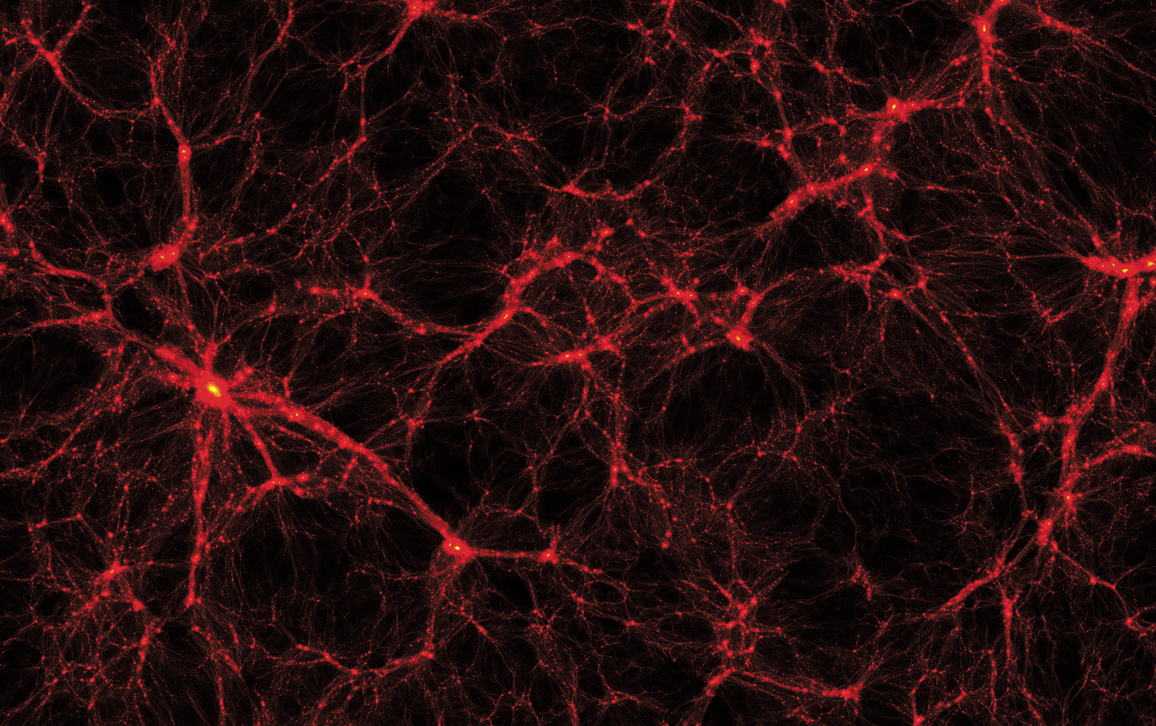
S. Gottlöber, G. Yepes, A. Klypin, A. Khalatyan/CLUES
The leading theory of the beginning of the universe, known as cosmic inflation theory, indicated that the total density of the universe should be considerably greater than what we observed, even after taking dark matter into account. We therefore thought it likely that an undiscovered dark energy in empty space—such as Albert Einstein’s cosmological constant, represented by the Greek letter lambda (Λ)—made up the rest of the density of the universe. Einstein had shown that Λ could counteract the gravitational attraction of matter. In a 1991 article, my colleagues and I worked out other implications of a cosmological constant, including how it would reduce the growth rate of cosmic structures such as galaxies and galaxy clusters. Dark energy received strong observational support in 1998, when two groups of researchers reported that the expansion of the universe is accelerating, a finding for which they shared the 2011 Nobel Prize in Physics.
The current version of ΛCDM theory—in which ordinary atomic matter makes up only about 5 percent of the density of the universe; dark matter, about 25 percent; and dark energy, the remaining 70 percent—correctly predicts in detail features of the cosmic microwave background (the relic heat radiation of the Big Bang). The theory also correctly predicts the distribution of mass in and around galaxies, the statistical properties of the distribution of the galaxies in space, and many other cosmic phenomena. Remarkably, there are no discrepancies known between the predictions of ΛCDM and the properties of the universe on large scales.
It has been more challenging to test our predictions at the scale of individual galaxies. In the ΛCDM universe, galaxies start as regions in which the density of matter, both dark and ordinary, is a little higher than average. The ΛCDM theory predicts statistically how often this should happen on every mass or length scale. As the universe expands, higher-density regions expand slightly slower than average because of their stronger gravity. When a given region becomes about twice as dense as average regions of the same size (on a time scale of millions to billions of years), it stops expanding and forms a gravitationally bound blob known as a dark matter halo.
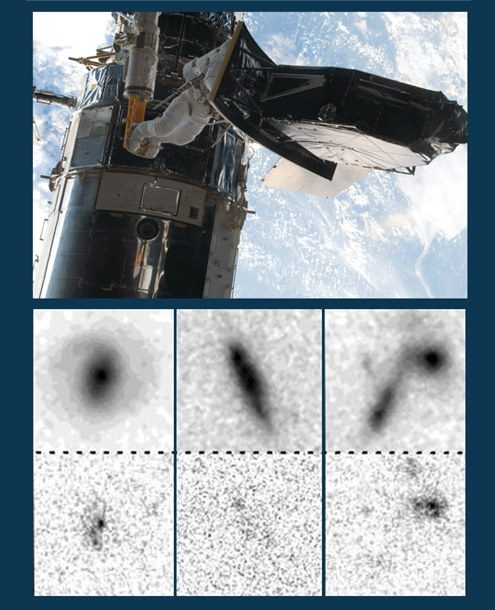
NASA; CANDELS/Images courtesy of the author.
Dark matter is called “dark” because it doesn’t emit, absorb, or reflect light. This property implies that the dark matter halos have no way to lose energy and contract. In contrast, ordinary matter within such halos can lose energy by radiation. For example, when atoms collide, their electrons are excited into higher energy levels, and when the electrons drop back into lower energy levels, characteristic wavelengths of light are emitted. As the ordinary matter loses energy, it falls toward the center of the dark matter halo and becomes denser.
We astrophysicists expected that as the gas in dark matter halos contracted, it would spin faster and form disks, in much the way that Laplace had explained the origin of planetary systems. Numerical models showed that if disk galaxies then collided, their stars would orbit in random directions and form spheroidal stellar systems resembling known elliptical galaxies or the fat bulges at the centers of spiral galaxies such as the Milky Way. We therefore expected disk galaxies to form first, spheroidal galaxies to form later from mergers of disk galaxies, and additional disks to arise sometimes as gas cooled and contracted around those stellar spheroids. To find out whether the real universe agreed with this expectation, we needed to look far back in time. Fortunately, the Hubble Space Telescope gave us a way to do that.
The farther away a galaxy is, the longer it takes for its light to travel to our telescopes. If we observe a forming galaxy whose light took 10 billion years to reach us, we see it as it was 10 billion years ago. When we look out in space, therefore, we see galaxies in earlier stages of their evolution. The expansion of the universe means that the light from those galaxies has stretched and reddened during its journey to Earth.
The universe has expanded by about a factor of three in each direction since about 10.5 billion years ago. The wavelength of the light emitted has expanded by the same factor, so that the wavelengths reaching us as visible light started as much-shorter-wavelength ultraviolet radiation, which is emitted mainly by the hottest, most massive, short-lived stars. To see what forming galaxies looked like, we want to observe instead the longer-wavelength light from ordinary stars such as the Sun. Due to cosmic expansion, that light reaches us from distant galaxies as infrared radiation.
On their last visit to the Hubble Space Telescope in 2009, the astronauts installed a new camera, called Wide Field Camera 3, which for the first time allowed Hubble to take many detailed images in infrared. Wide Field Camera 3 is the instrument that made possible a project we called the Cosmic Assembly Near-infrared Deep Extragalactic Legacy Survey (CANDELS)—the largest-ever Hubble observing program. It finally gave us the ability to see what forming galaxies really look like and to test the predictions from galaxy-formation models.
The results were a revelation. Earlier images from Hubble’s Advanced Camera for Surveys, showing what forming galaxies look like in visible light, provided only a sketchy look at where stars were forming within early galaxies. The infrared capabilities of the new Wide Field Camera 3 revealed the full stellar populations in those forming galaxies.
Here in the modern universe, we live in the disk of the Milky Way galaxy, which has a spheroid at its center; from the side, it somewhat resembles a fried egg. Other large nearby galaxies are also combinations of stellar disks and spheroids; in addition, we see some pure stellar spheroids, called elliptical galaxies. We expected that early galaxies would look different, but the actual shapes that we saw still surprised us.
Galaxies, like people, go through a process of aging.
The Hubble images showed that many forming galaxies are long and narrow, like a pickle. To be sure that the pickle shapes were not just a perspective effect, the CANDELS team did a statistical analysis of the distribution of the ratio of the short axis to the long axis in the observed galaxies. Regardless of orientation, spheroids will always have a long/short ratio equal to about 1. Disks seen in various orientations will have a short/long ratio roughly evenly distributed between about 1 (face-on) and about 0.2 (edge-on). But most of the forming galaxies are observed to have an axis ratio of about 1:3, with only a small fraction of axis ratios larger than about 2:3. Most of those young galaxies cannot be disks or spheroids; they must truly be pickle-shaped. We have recently confirmed this observation with a more sophisticated analysis of CANDELS images of distant galaxies.
The Hubble images revealed other oddities as well. Most forming galaxies contain giant clumps of stars, which are tens to hundreds of times more massive and significantly larger than those in nearby galaxies. Also, we had naively expected that galaxies would progressively increase in size as they grew in mass, since nearby galaxies are larger the more massive they are. But Hubble observations implied instead that massive forming galaxies typically undergo one or more compaction events that rapidly shrink the radius that encloses half their light.
Until a few years ago, it was obvious that even the best galaxy simulations were not much like real galaxies. But over the past decade, making use of increased supercomputer power and improved simulation codes, we astrophysicists have started producing simulated galaxies that closely match the images and spectra both of nearby galaxies and of galaxies in the early universe.
Those recent improvements in galaxy simulations have led to notable advances in several broad areas. We now begin with more realistic initial conditions, apply more detail in the simulated astrophysics, and observe significantly finer resolution in the structures that emerge in our models.
Simulation and video by Daniel Ceverino in collaboration with the author.
When we saw the unexpected pickle-shaped galaxies in the Hubble images, my colleagues and I went back to examine the galaxies in the simulations that we had already run. We discovered that our simulated galaxies were also pickle-shaped! We just hadn’t thought to look for such shapes. We had assumed that forming galaxies would be disk-shaped, probably because the Laplace nebular hypothesis was still in the back of our minds. Of course, I would have much preferred to have predicted in advance that forming galaxies would be pickle-shaped, but it was reassuring to see the fundamentals of our models validated.
Our simulations allowed us to understand why early galaxies are pickle-shaped. Galaxies do not form in isolation; rather, they emerge along the long filaments of dark matter, called the cosmic web, that bind together the entire universe. Our Laplacian intuition had failed to take into account the gravitational effects of all that unseen mass. Forming galaxies are woven into the cosmic web, their visible stars tracing its elongated distribution of invisible matter.
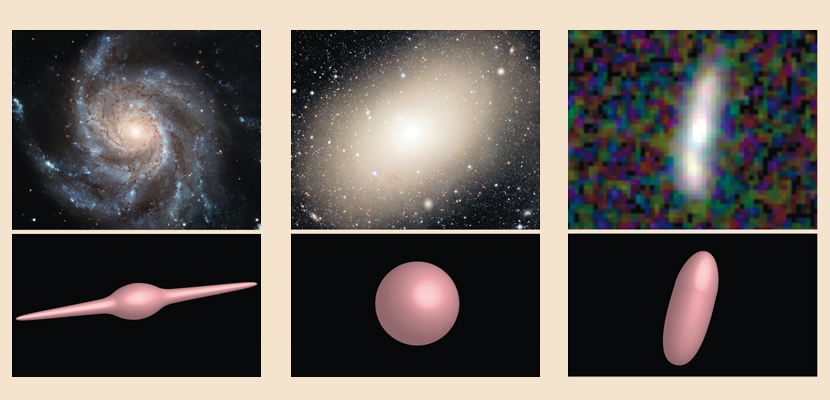
NASA; CFHT observatory; Barbara Aulicino
The cosmic web is made visible in my group’s Bolshoi-Planck simulation of large-scale structure, which we ran on the Pleiades machine, NASA’s most powerful supercomputer. In the simulation, most dark matter halos (which seed the formation of visible galaxies) start out elongated because they are fed from the narrow dark matter filaments along which they form, like beads on a string. The Sloan Digital Sky Survey, which has extensively mapped the nearby universe, confirms that galaxies do indeed follow just such a filamentary distribution. Our simulation also produces large cosmic voids where very few dark matter halos are found. The Sloan Survey likewise shows many such voids in the distribution of galaxies.
Our high-resolution VELA simulations of individual galaxies predict that elongated forming galaxies tend to be oriented with their long axes along the cosmic web, pointing toward other nearby galaxies. We are in the process of testing this prediction with the CANDELS observations. The model makes another notable prediction. The stars in pickle-shaped galaxies should be supported (that is, prevented from collapsing gravitationally) by random velocities that are greater along the long axis and lesser along the shorter axes than would be the case for rotation in galactic disks. We therefore expect to see stars in pickle galaxies on elongated orbits with no net rotation. Verifying that prediction will be challenging.
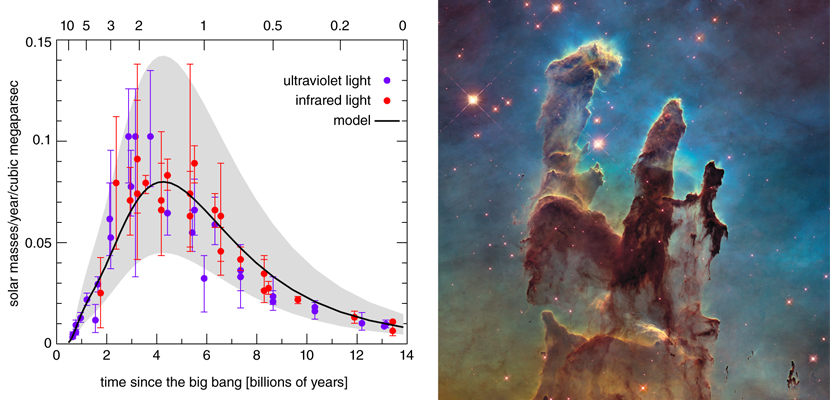
Aldo Rodriguez; NASA/ESA/Hubble and the Hubble Heritage Team
Spectroscopic measurements can determine whether the elongated galaxies are rotating, but the measurement is a delicate one. To test our simulation, we will have to carefully compare predicted and observed stellar spectra in distant young galaxies, something that is currently beyond the reach of the largest ground-based telescopes. Fortunately, the James Webb Space Telescope (JWST), now due to be launched in 2021, will be able to take spectra of galaxies even more distant than those whose stellar populations we have seen with Hubble. JWST will be able to test our prediction that the progenitors of galaxies with masses as great as or greater than that of the Milky Way were pickle-shaped and were not rotating at early times, when the universe was less than one-quarter its present age of 13.8 billion years. With its larger mirror, JWST will also gather much more light and make sharper images of early galaxies than Hubble can.
Once we realized that our simulations were already producing pickle galaxies, we wanted to learn more about how they evolved into the familiar forms astronomers see in the modern universe. In our computer models, the pickle-shaped galaxies are mostly made of dark matter, even at their centers, where their stellar density is highest. We found that the simulated galaxies do not remain pickle-shaped for long, however.
The halos surrounding these galaxies continue to accrete dark matter and gas. Some of that gas cools and falls into the central region of the galaxy, where it forms stars. After the stellar mass of a simulated galaxy has grown to about one-tenth the mass of the Milky Way today (generally over the course of a few billion years), the galaxy typically experiences one or more rapid inflows of gas into its central region. This gas is rapidly converted to stars; the forces and torques of this growing central lump of stars tend to make the elongated orbits of the stars and dark matter rounder. When large numbers of new stars are born, there are always a few massive ultrabright ones that live only for a few million years. Rapid inflows of gas into the center of a forming galaxy can produce such an intense burst of bright new stars that the galaxy’s light appears to become much more tightly concentrated toward the center. This process evidently accounts for the compaction events deduced from studying many Hubble images of early galaxies.

Images courtesy of the author.
In our VELA galaxy simulations, inflows and compaction events occur for several different reasons. One cause is mergers of comparable-mass galaxies, in which the gravitational forces and gas interactions can cause a large fraction of the cool, dense gas to flow into the center of the forming galaxy and form stars there. Another, more common cause is instabilities in the dense gas disks that form in the early universe. Such instabilities are often triggered by smaller galaxies merging with larger ones, or by a galaxy just passing nearby. Compaction can also occur when gas flows into the galaxy from two or more directions, creating counterrotating flows. We are now working to come up with observational tests that can clarify which, if any, of the processes seen in our simulations are responsible for compaction observed in real galaxies.
With our VELA galaxy simulations, we are making progress in understanding another distinctive characteristic of early galaxies, one that may be related to the compaction process. Hubble images reveal massive off- center clumps of stars in a majority of the galaxies that were forming when the universe was 2 to 4 billion years old, and in a majority of lower-mass galaxies that were forming at later times. These clumps are orders of magnitude more massive than the most massive globular clusters or star-forming regions in nearby galaxies.
Our simulations show that there are many such massive clumps in forming galaxies, especially in disks forming after compaction, because those galaxies contain so much gas. Relatively small local concentrations in the gas occur randomly, and they can also be initiated by interactions with nearby galaxies. Because a lot of gas is present, the concentrated regions can gravitationally attract more gas, and the resulting clumps of gas can form many stars and become quite bright.
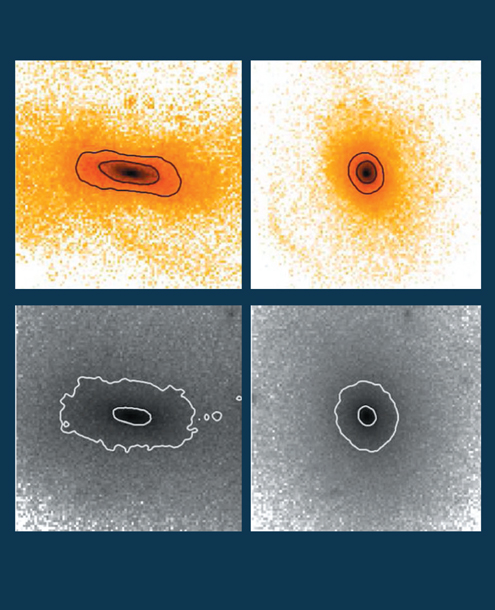
Images courtesy of the author.
Massive clumps should then fall inward as they interact gravitationally with the objects around them, a process that astrophysicists call dynamical friction. In our models, the clumps migrate to the galaxy center in a few hundred million years, ultimately joining the forming galaxy bulge. This explanation predicts that clumps closer to the center should contain mostly older stars, matching observations. It also explains why massive clumps are not seen in nearby galaxies: Clumps that formed early would have migrated to the galaxy centers long ago, and new massive clumps don’t form because mature galaxies contain much less gas than forming galaxies.
Despite these impressive achievements, our understanding of galaxy formation is still far from complete. For one thing, not all other simulations match up with our results. In particular, the simulations of the Feedback in Realistic Environments (FIRE) team, led by Phil Hopkins of the California Institute of Technology, do not have long-lived star-forming clumps, even though they operate at a similar resolution. I am coleading a project called Assembling Galaxies of Resolved Anatomy (AGORA), which is systematically comparing all the major galaxy-simulation codes. We are attempting to model the same galaxies with the same astrophysical assumptions using these different codes to understand why the results sometimes differ and to see which aspects agree best with observations.
We also encounter puzzles in other simulations that model cosmic structure on a very large scale. My group, the FIRE group, and other groups doing high-resolution galaxy simulations can afford to model only a relatively small number of galaxies, because each galaxy simulation consumes a great deal of supercomputer time. Several other groups—including Illustris, Evolution and Assembly of Galaxies and their Environments (EAGLE), and Horizon-AGN—have run lower- resolution simulations of large volumes containing many thousands of galaxies. These large-scale simulations focus on comparison with the more recent, nearby parts of the universe. The simulations have more or less succeeded in reproducing the main trends of the nearby galaxy population, but they disagree on basic properties such as the sizes of the galaxies, both among themselves and also in comparison with the observations.
I’ve focused here mainly on understanding the early formation stages of galaxies, but the modern universe poses plenty of mysteries as well. Observations have revealed a number of regularities across diverse populations of galaxies, and explaining them is a major challenge. One such regularity is a correlation between the internal velocity of the stars and gas in a galaxy and its total stellar mass: the higher the velocity, the larger the stellar mass. There is also a fairly tight correlation between the total stellar mass of galaxies and the mass of their dark matter halos.
In large spiral galaxies such as the Milky Way, the mass of the dark halo is about 30 times that of the visible stars. In both smaller-mass and larger- mass galaxies, that ratio is higher still. Across the universe as a whole, though, dark matter outweighs ordinary matter by about 6 to 1. Therefore, the vast majority (at least 80 percent) of the ordinary matter in these galaxies has never cooled and reached high enough densities to form stars. Determining the distribution of this gas in and around galaxy halos is a major unsolved problem.
Will our galaxy wind down and go dark? Not anytime soon at least.
About a decade ago, evidence began to accumulate for another galactic regularity, this one concerning a universe-wide decline in stellar births. Most star-forming galaxies create new stars at a rate that is proportional to their stellar mass, to within about a factor of two, during any cosmic epoch. The star formation rate divided by the total stellar mass in a galaxy is called the specific star formation rate. This specific rate has declined by about a factor of 10 since the period of greatest star formation, when the universe was 2 billion to 6 billion years old.
Today, most galaxies in the nearby universe that are more massive than the Milky Way are quenched—that is, they have essentially stopped forming stars. It’s not that they do not have enough gas, but rather that the gas they have doesn’t cool efficiently and become dense enough to form stars. We astronomers are still trying to understand why this happens. The supermassive black holes in the centers of massive galaxies may be at least partly responsible. Gas falling toward such black holes is tremendously heated, so that relatively small amounts of accreted gas can produce huge amounts of radiation. Perhaps just a trickle of gas into supermassive black holes is enough to prevent the gas in and around older galaxies from cooling enough to form stars.
Quenching is causing the appearances of galaxies (and hence the universe as a whole) to change over time. Galaxies that are actively forming stars are full of the ultraluminous blue stars that live only a few million years. Once a galaxy stops forming stars, its light comes mainly from older stars, including red giant stars, so we say that such galaxies are “red.” We can compare regions of the universe at different times by counting galaxies of different types in a reference volume that expands with the expansion of the universe. When we do, we find that the proportion of red galaxies has been steadily growing for many billions of years since the early universe. The turning point, when the mass of red galaxies was about equal to that of star-forming galaxies, was about 7 billion years ago.
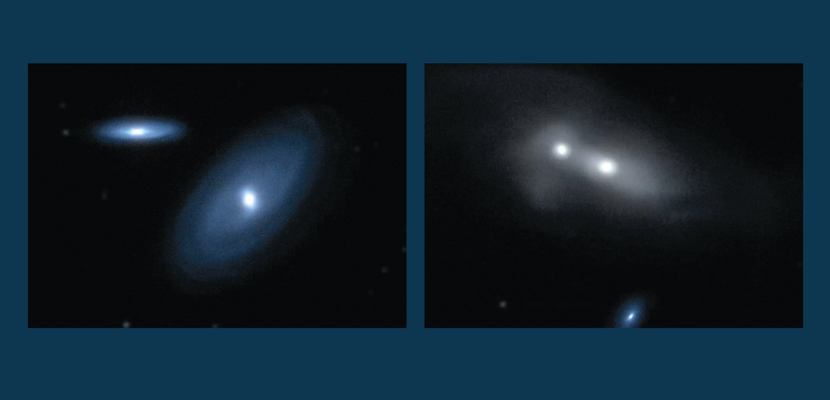
Scientific Visualization Studio/Goddard Space Flight Center/NASA
Galaxies form stars most efficiently when they are about one-thirtieth to about one-third the current mass of the Milky Way. (Lower-mass galaxies have such weak gravity that supernova explosions can blow much of the star-forming gas out of their central regions; higher mass galaxies have their star formation impeded by radiation from the supermassive black holes at their centers.) The most massive galaxies passed through this mass range 10 billion or more years ago as they kept accreting more material, whereas lower-mass galaxies are just now entering the range. Interestingly, the total mass of star-forming galaxies has been roughly constant for more than 10 billion years, but the mass of red galaxies has been growing steadily as massive galaxies stop forming stars while lower-mass galaxies become actively star-forming.
Thus, galaxies, like people, go through a process of aging. In their youth, they have periods of rapid growth in their stellar masses, followed by a slowing in their adolescence, and very little or no growth when they have reached maturity. Our own galaxy, the Milky Way, is well on its way into red adulthood. Will our galaxy therefore wind down and go dark? Computer models can give us some insights here, too, and the answer is, Not any time soon!
We can anticipate the far future using two types of models: simulations of galaxy dynamics and also ones of stellar evolution. Stars like the Sun get brighter as they age, because the fusion furnaces in their cores must counteract the increasing replacement of their hydrogen fuel by the helium formed by fusing hydrogen. On a timescale of many hundreds of millions of years, our warming Sun will cause the Earth to become too hot for life, unless our distant descendants learn how to perform planetary-scale engineering projects.
For our galaxy as a whole, the brightening of common Sun-like stars will balance out the lost light from the brilliant blue stars that are no longer forming. But the Milky Way will also get a big boost in about 5 billion years, when it will merge with its giant neighbor, the Andromeda galaxy. That merger will produce a new, combined elliptical galaxy that we might call Milkomeda. Other nearby galaxies will also merge with Milkomeda. All these mergers will probably cause rejuvenating bursts of star formation.
The vast reservoir of gas in the Milky Way and its successors will continue to cool and form stars into the distant future. Even then, Milkomeda won’t fade away for a very long time. Most of the Milky Way’s stars are somewhat less massive than the Sun, and will live much longer. They will gradually become more luminous, and because there are so many of them, Milkomeda is expected to be as bright as the Milky Way and Andromeda are now more than a trillion years in the future—a hundred times the present age of the universe!
Long before then, perhaps a hundred billion years from now, there may be no other visible galaxies for future astronomers to study. If dark energy keeps the expansion of the universe accelerating the way it is now, all other galaxies will be receding from us so rapidly that they will be out of view. The discovery of dark matter helped us understand the origins of other galaxies, but dark energy might prevent our distant descendants from witnessing the fates of those galaxies.
This is just speculation, however. Right now we know little about the nature of dark matter, and even less about dark energy. Perhaps we will need another Newton to discover fundamental physical laws governing the invisible universe, and another Laplace to appreciate how it all came to be and how it will all end.
Click "American Scientist" to access home page
American Scientist Comments and Discussion
To discuss our articles or comment on them, please share them and tag American Scientist on social media platforms. Here are links to our profiles on Twitter, Facebook, and LinkedIn.
If we re-share your post, we will moderate comments/discussion following our comments policy.